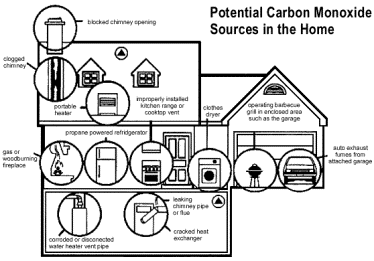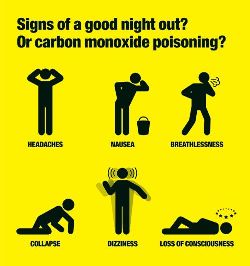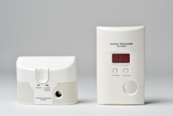
Often called the silent killer, carbon monoxide (CO) is an invisible, ordorless, colorless gas created when fuels (such as gasoline, wood, coal, natural gas, propane, oil, and methane) burn incompletely. In the home, heating and cooking equipment that burn fuel can be sources of carbon monoxide.
Each year in America, unintentional CO poisoning claims more than 500 lives and sends another 15,000 people to hospital emergency rooms for treatment. The presence of CO is virtually undetectable. Because you can't see, smell or taste it, prolonged exposure to CO can result in varying degrees of illness up to and including death. Everyone is at risk, but those most at-risk for serious injury from CO exposure are pregnant women, children, the elderly and anyone with a heart or lung condition.
Carbon monoxide enters the body through breathing. CO poisoning can be confused with flu symptoms, food poisoning and other illnesses. Some symptoms include shortness of breath, nausea, dizziness, light headedness or headaches. High levels of CO can be fatal, causing death within minutes.

Safety Tips
- CO alarms should be installed in a central location outside each sleeping area and on every level of the home and in other locations where required by applicable laws, codes or standards. For the best protection, interconnect all CO alarms throughout the home. When one sounds, they all sound.
- Follow the manufacturer's instructions for placement and mounting height
- Choose a CO alarm that has the label of a recognized testing laboratory.
- Test CO alarms at least once a month; replace them according to the manufacturer's instructions.
- If the audible trouble signal sounds, check for low batteries. If the batter is low, replace it. If it still sounds, call 9-1-1.
- If the CO alarm sounds, immediately move to a fresh air location outdoors or by an open window or door. Make sure everyone inside the home is accounted for. Call for help from a fresh air location and stay there until emergency personnel arrive.
- Do not run a vehicle or other fueled engine or motor indoors, even if the garage doors are open. Make sure the exhaust pipe of a running vehicle is not covered by snow.
- During and after a snowstorm, make sure vents for the dryer, furnance, stove, and fireplace are clear of snow build-up.
- A generator should be used in a well-ventilated location outdoors away from windows, doors, and vent openings.
- Gas or charcoal grills can produce CO – only use outside.
What actions do I take if my CO alarm goes off?
- If no one is feeling ill:
- Silence the alarm.
- Turn off all appliances and sources of combustion (i.e. furnace and fireplace).
- Ventilate the house with fresh air by opening doors and windows.
- Call a qualified professional to investigate the source of the possible CO buildup.
- If illness is a factor:
- Evacute all occupants immediately.
- Determine how many occupants are ill and determine their symptoms.
- Call 9-1-1 and when relaying information to the dispatcher, include the number of people feeling ill.
- Do not re-enter the home without the approval of a fire department representative.
- Call a qualified professional to repair the source of the CO.
Know the symptoms of CO poisoning.

Because CO is odorless, colorless, and otherwise undetectable to the human senses, people may not know that they are being exposed. The initial symptoms of low to moderate CO poising are similar to the flu (but without the fever). They include:
- Headache
- Shortness of breath
- Nausea
- Dizziness
High level of CO poisoning results in progressively more severe symptoms, including:
- Mental confusion
- Vomiting
- Loss of muscular coordination<
- Loss of consciousness
- Ultimately death
Protect yourself and your family from CO poisoning.

- Never use your range or oven to help heat your home and never use a charcoal grill or hibachi in your home or garage.
- Never keep a car running in a garage. Even if the garage door is open, normal circulation will not provide enough fresh air to reliably prevent a dangerous buildup of CO.
- When purchasing an existing home, have a qualified technician evaluate the integrity of the heating and cooking systems, as well as the sealed spaces between the garage and house. The presence of a CO alarm in your home can save your life in the event of CO buildup.
*Sources: United States Fire Administration and the National Fire Protection Association.*
